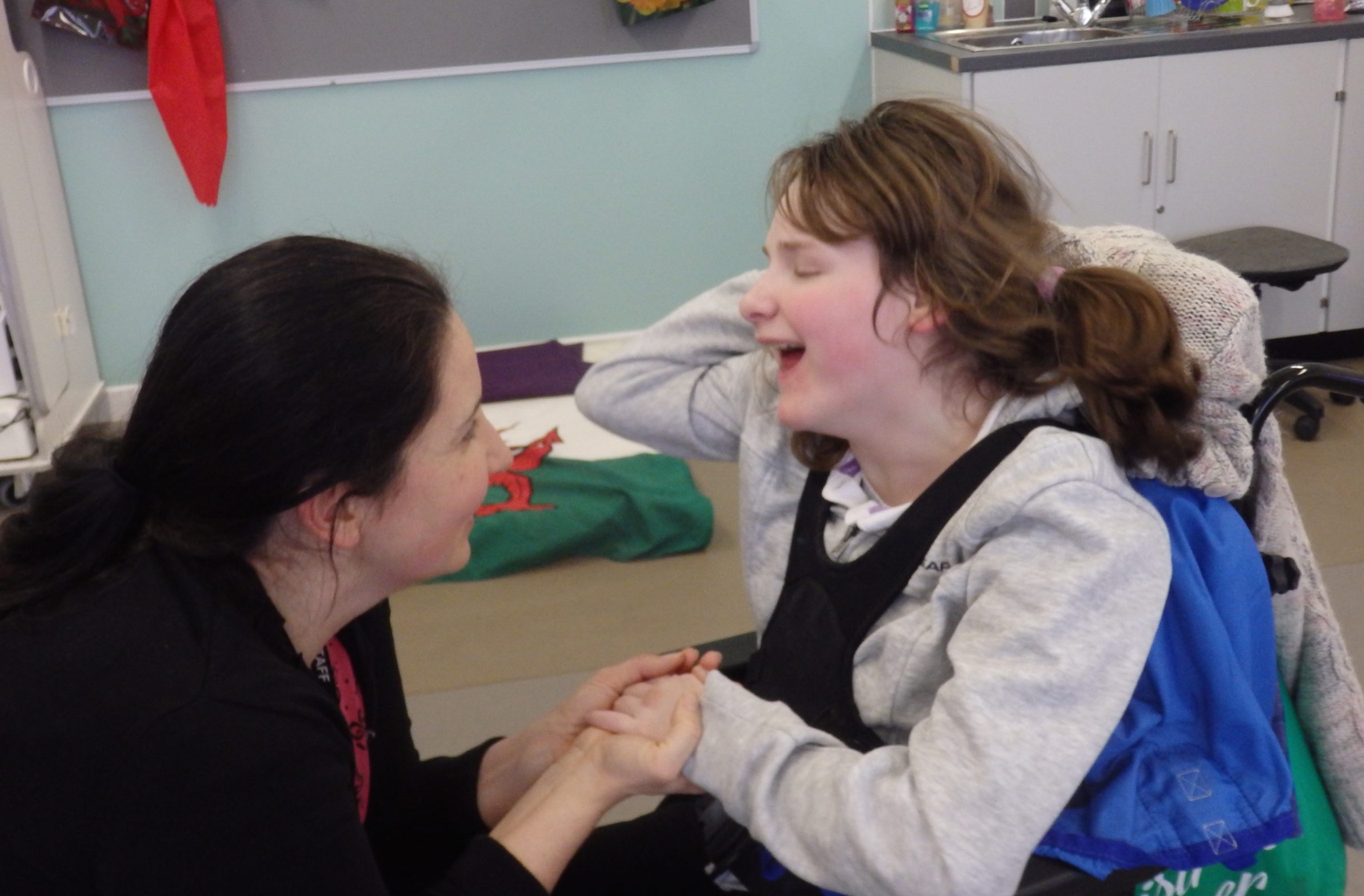What are the practical implications of introducing the Story Massage Programme to a class of children with PMLD? And how can these be overcome? Here are some helpful guidelines from Heather North, written while she was a class teacher at Lexden Springs Special School. Indeed, Heather, who is pictured below (right) found the programme to be so beneficial that she wrote a special massage story as a fun way of presenting her work at a teachers’ meeting!
Heather’s Massage Story for a Teacher’s Meeting
Before looking at Heather’s suggestions for implementing the Story Massage Programme to a class of pupils (aged 6-10 years) with PMLD, take some time to enjoy her massage story which is an ideal summary of her experiences.
Story Massage in Green Class
First it was noisy and rushed. (The Drum)
Now it is calm and hushed. (The Calm)
Before the children just couldn’t wait. (The Claw)
Now they’re learning to anticipate. (The Wave)
The power point reinforces every word. (The Fan)
Of the story they’ve just felt and heard. (The Walk)
The pictures may be focal (The Circle)
But even the quietest children become quite vocal. (The Sprinkle)
They express their preferences, wanting ‘more’, (The Bounce)
Tolerating more touch than they ever did before. (The Squeeze)
For Green Class, Story Massage has been a positive tool. (The Fan)
That would benefit many children in the whole school. (The Circle)
About Green Class
Green Class consists of 11 children with Profound and Multiple Learning Difficulties (PMLD) and global development delay. Pupils range in age from 6 – 10. One child has a few spoken and signed words. The other children rely on vocalisations, facial expressions and body movements. Two children have multi-sensory impairments and two children are on the Autistic Spectrum. Many of the children have complex medical needs and require tube feeding. There are six members of staff including the teacher.
Factors to consider when implementing the Story Massage Programme for children with PMLD
During her training, Heather immediately recognised the benefits for pupils with PMLD and was keen to introduce it to her class. However, Heather found that there were seven main practicalities that needed consideration when introducing the programme to children with PMLD:
- Demonstrating massage stories to members of staff
- Encouraging children to accept touch
- Scheduling Story Massage sessions
- Creating the right environment
- Positioning of pupils
- Linking to the Curriculum
- Assessment and record-taking
Heather explains how she has worked to create Story Massage sessions that are fully inclusive for all children in her class.
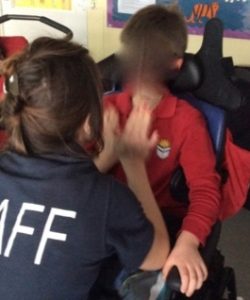
1. Demonstrating the programme to members of staff
Heather introduced the idea of the programme at a teachers’ meeting and then put time aside to show staff in Green Class how to do the ten strokes and talk about the benefits of positive, respectful touch through Story Massage activities. This was an ideal time for staff to ask questions and work together to share ideas for how it would best benefits their pupils. The staff are aware that they are not trained in and work under the guidance of Heather. She encouraged them to take the online training course.
2. Encouraging children to accept touch
At first the staff were a little concerned about introducing touch to children that they did not know very well. But they found that the programme helped to create trust and security, so actually contributed to healthier, interactive relationships between pupils and staff. “Staff know the importance of interacting in a respectful way, using a nurturing voice and choosing the best position for the child,’ says Heather, “The children are always asked if we may give them a story massage and thanked at the end. As the staff got to know the children they became increasingly skilled at interpreting responses and making appropriate adjustments to pressure and choice of strokes.”
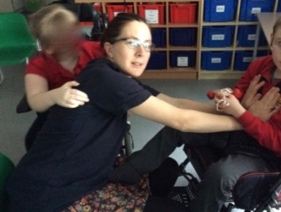
3. Scheduling Story Massage sessions
Initially, some of the staff said they felt rushed and there were many interruptions to the sessions. “When I first did the Story Massage training, I was so excited that I wanted to introduce it straightaway,” explains Heather, “but it was not timetabled and so we were not always prepared. We have now earmarked time for Story Massage sessions as part of the timetable. This means that we can try to do changes and complete feeds and flushes before the session. We also choose times when there are fewer children in the classroom due to others attending different activities.”
4. Creating the right environment
Heather says that Green Class tends to be rather busy, noisy and cluttered so she dimmed the lights and pulled down the blinds to help create a calmer environment for sessions.
Many of the children found it hard to wait their turn so Heather created power points with the massage plus the symbol for the matching stroke. This helped children with vision to wait calmly as they listened to the story and watched the associated images. “It also served as a memory prompt for the adult telling the story and reminded staff which strokes to use,” Heather says, “The children benefited from the increased repetition hearing the story several times. We use the same stories for at least half a term. We find this helps encourage anticipation and interaction.”
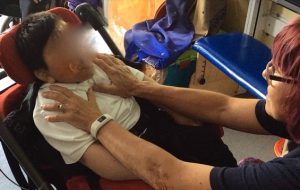
5. Positioning of pupils
Heather was concerned that it would be difficult to to get to children’s backs because of specialist seating. And there was not sufficient time for getting children out of chairs.
However, this hurdle was easily overcome when staff learnt to adapt strokes dependent on the child’s positioning. “We have had to consider what is acceptable for each child, linked to their chronological age, developmental age, physical development, disabilities and their preferences,” says Heather, “On one young girl, we currently use the strokes on the front of her body as well as on her limbs and head. But I am aware that this will not be possible for much longer as she physically develops.”
Heather has also introduced a bench into Green Class where those who are physically able can sit to have their Story Massage session.
6. Linking to the curriculum
This has worked well for Heather. “I have linked in to English, PHSE and Humanities through adapting existing stories or by writing my own,” she explains. You can see a video of Heather’s wonderfully creative massage story about the history of transport below.
7. Assessment and record-taking
At first, Heather began using a scoring grid for assessing responses to massage stories. However, Heather says that because they use their hands so much during Story Massage sessions, it proved very difficult and was also quite subjective. “It worked best for those children who worked with the same adult every time as there was increased consistency,”she explains, “We have found videoing was the most efficient method as it allows for more effective triangulation than photographs. We now have a stand for the iPad so that we are not reliant on a staff member for doing the videoing.”
And the results of the assessment process are below. This was gained through observation, photographs, video clips, assessment sheets and staff feedback forms.
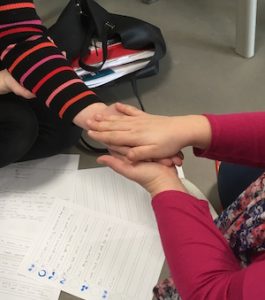
Benefits of the Story Massage Programme for Learners with PMLD
Heather says that members of staff all felt that the children enjoyed and have benefitted from positive touch activities through the programme in the following ways:
- They are calmer during and after the session.
- They are increasingly showing signs of anticipation (by tensing, breath holding, vocalising, smiling etc.).
- They are increasingly demonstrating preferences for strokes (using facial expressions, body movements, vocalisations etc.).
- They are more accepting of touch.
- Increasingly indicating they want ‘more’ to the adult through spoken word, supported signing, vocalisations etc.
- They are more responsive to the adult working with them.
- One girl in particular has been able to do it on an adult although she is not yet ready to work with another child. She has also started to try and ‘tell’ the story with the lead adult.
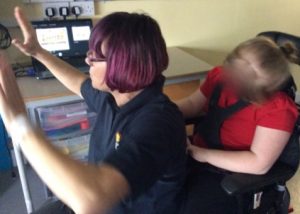
More about the Story Massage Programme
The Story Massage Programme of ten simple strokes combines the benefits of positive, respectful touch with the creativity and engagement of storytelling. These strokes have a child friendly name, such as The Circle or The Sprinkle, and an easy to recognise symbol making it accessible for all. It is a fully inclusive activity, no clothing is removed and no oil is used. Stories can be taken from our Story Massage book, adapted from favourite stories or songs. or you can even create your own stories like Story Massage in Green Class!
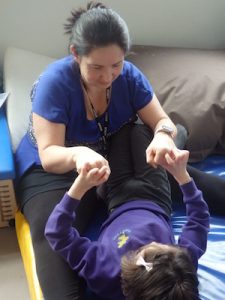
Would you like to train in the Story Massage Programme?
Are you inspired by the way that Heather is using sensory stories with children with PMLD?
If you would like to use the programme at home or work then you will love our flexible online course. All the information is here: Online Training Course.
You will learn how to share the ten Story Massage strokes, adapt familiar stories and even create some sensory stories of your own. Ideal for well-being coaches, therapists, teachers, SEN staff, support staff, Early Years practitioners, those working with people with additional needs, everyone with an interest in sharing positive touch activities with adults or children
